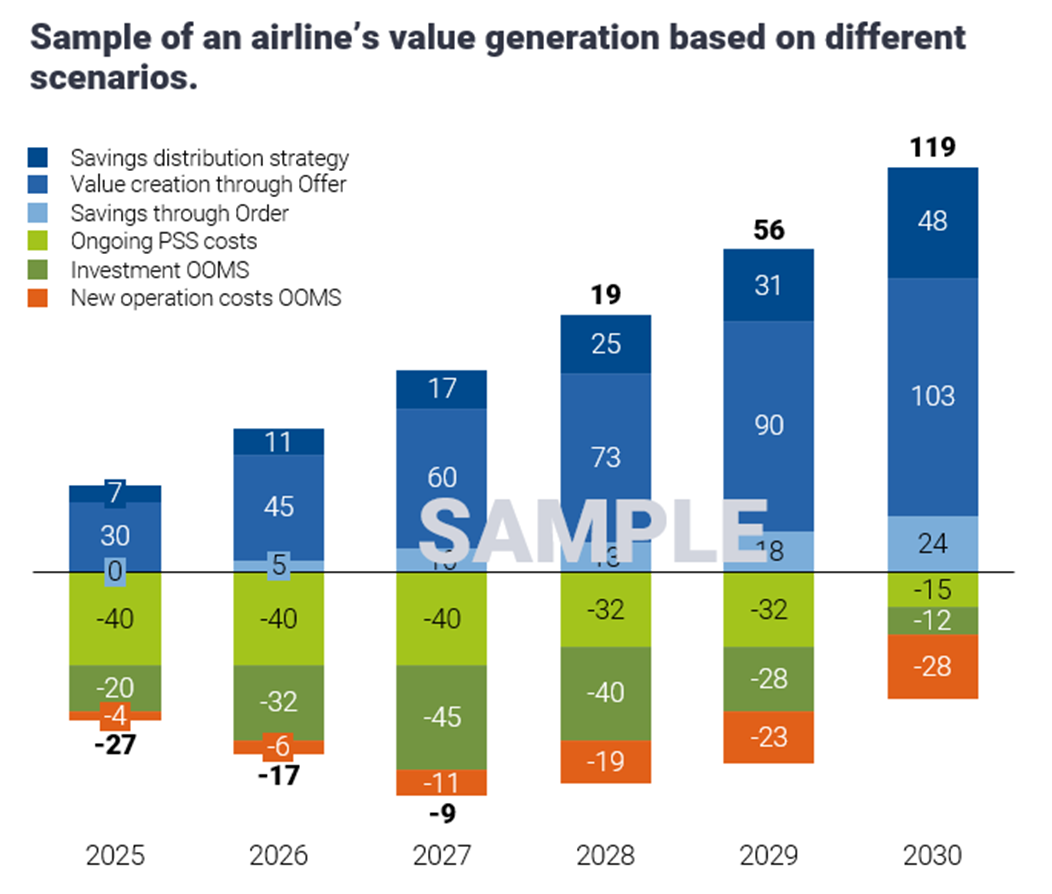The global airline industry is undergoing major transformation. Airlines are no longer just carriers of passengers; they are now retail ecosystems, driven by data and technology. At the heart of this digital revolution is Offer & Order Management (O&O), a modern framework reshaping how airlines create, sell, and fulfill travel experiences.

But what do these concepts really mean for your airline, and where is the industry today?
To get answers to these questions, we invited Daniel Friedli, CEO at Travel in Motion, for an engaging session that demystifies the Offer and Order framework, explores the current landscape, and uncovers where airlines can unlock real value.
This blog explores why Offer & Order Management is paramount, how a modular approach to transformation creates value step-by-step, and how airlines can align commercial and IT strategies for success. If you’re a commercial leader or IT executive looking to future-proof your airline’s business model, this piece is for you.
Why Offers & Orders Are Essential Now
Legacy Passenger Service Systems (PSS) have long been the backbone of the airline industry. However, these systems, while reliable, limit agility and scalability in today’s dynamic marketplace. Airlines using outdated systems face challenges in tailoring offers, meeting customer demands, and responding timely to market conditions.
Offer & Order Management modernizes this framework by enabling:
- Dynamic Retailing: Tailored, real-time offers that adapt to customer preferences and market shifts.
- Operational Efficiency: Streamlined processes that reduce servicing costs and human error.
- Scalability: Systems that adjust seamlessly to support airline growth and innovation.
Early adopters from IATA’s Airline Retailing Consortium have already begun integrating Offer & Order systems and are setting the industry benchmark for modern retailing.
The Case for Modular Transformation
A common misconception is that adopting Offer & Order Management requires a complete retail infrastructure overhaul and replacement of legacy systems. The reality? Airlines can transform incrementally, using modular architectures that layer new capabilities over existing systems.
Why Choose a Modular Approach?
- Phased Investment: Modular systems allow airlines to spread costs over time, delivering faster ROI with minimal disruption.
- Interoperability: Airlines can avoid vendor lock-in and ensure new components integrate seamlessly with their current systems.
- Flexibility: Modular solutions can adapt to changes in strategy and market conditions without overhauling the entire system.
For example, instead of replacing their entire PSS environment, hybrid models combine legacy systems with best-in-class modules for offer optimization and personalized distribution.
Building the Business Case for O&O Transformation
Unlike traditional investments, the benefits of Offer & Order Management start accruing before full implementation. Airlines can deliver continuous value at every stage of the transition, allowing the airline to generate revenue and reinvest in the transformation.
 |
Daniel Friedli
CEO, Travel in Motion |
Key Value Drivers
1. Enhanced Distribution:
- Shifting from traditional channels to NDC (New Distribution Capability) reduces dependency on costly intermediaries and allows putting emphasis on the Offer.
- Improved interline connectivity expands market reach.
2. Optimized Offers:
- AI-powered segmentation and personalization drive ancillary sales and increase per-passenger revenue.
- Streamlined bundling and unbundling allow for more relevant customer options.
3. Reduced Servicing Costs:
- Elimination of agency debit memos (ADMs) and manual processes reduces post-sale expenses.
- Increased automation minimizes errors in pricing, refunds, and servicing.
Real-World ROI Insights
Airlines that adopt O&O systems typically begin seeing substantial ROI in Year 4 or 5. Industry benchmarks suggest a $7+ incremental revenue per passenger boarded (PB), with continuous value growth as the system matures.
 |
Daniel Friedli
CEO, Travel in Motion |
For example:
- Scenario 1: An airline that incrementally integrates offer optimization components starts generating noticeable ROI within 2 years.
- Scenario 2: A full-scale O&O implementation may take longer to achieve ROI, but delivers higher long-term value.

Travel in Motion
Navigating the Transition to O&O
Implementing Offer & Order Management requires strategic planning, collaboration, and adaptability. Here’s how airlines can turn vision into execution.
1. Assess Readiness
Every airline’s transformation roadmap is unique. Start by evaluating the current tech stack, business processes, and organizational maturity. Consultants and vendors can bring valuable expertise to this evaluation, helping to identify strengths and gaps. Tools like POCs (proof-of-concepts) and scenario modeling also play a key role in this process.
2. Create a Tailored Roadmap
Roadmaps should prioritize high-impact areas, such as offer optimization and direct distribution, while planning gradual integrations for other components.
Key Focus Areas:
- System interoperability
- Vendor selection and management
- Process redesign to align with a digital-first approach
3. Enable Organizational Collaboration
A successful transformation involves teamwork between commercial and IT departments:
- Commercial leaders can champion the customer-centric benefits of O&O, ensuring buy-in across revenue management, distribution, and digital sales.
- CIOs and CDOs play a pivotal role in prioritizing cloud-native, modular ecosystems that inspire confidence internally and externally, and allow for growth and scale.

Travel in Motion
Aligning Commercial Ambitions with IT Muscle
Airlines need more than just technology to succeed with Offer & Order Management; they need alignment between commercial and IT goals. Key leadership imperatives for navigating this shift include:
- Strengthen Data-Driven Decision-Making:
Commercial departments rely on IT to provide actionable insights from customer data, enabling personalization and dynamic pricing strategies.
- Bridge Communication Gaps:
Regular collaboration between teams ensures commercial goals align with technical capabilities.
- Invest in Training:
Upskilling both commercial and IT staff ensures the organization can make the most of the capabilities O&O systems offer.
Unlock Value with Offers & Orders
The transformation to Offer & Order Management isn’t just a technical upgrade; it’s a shift in how airlines perceive and deliver value. By adopting a modular, flexible approach and focusing on continuous value generation, airlines can position themselves for long-term success in today’s competitive market . IT vendors and expert consultants are here to support you every step of the way, working together with the industry community to drive meaningful change and shape the future of air travel. Let’s make it happen — together.
